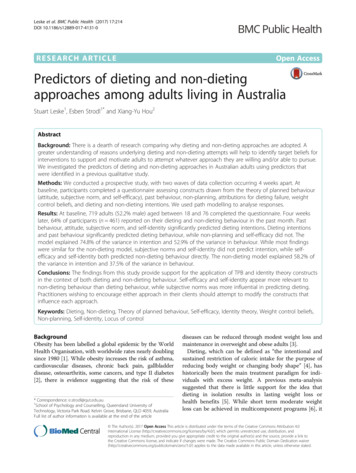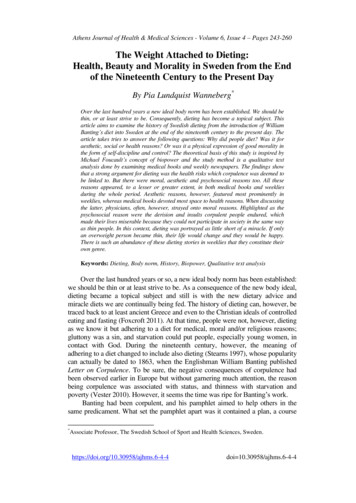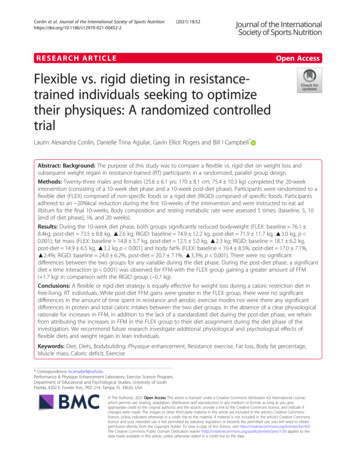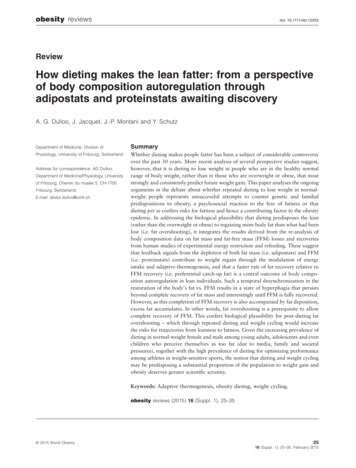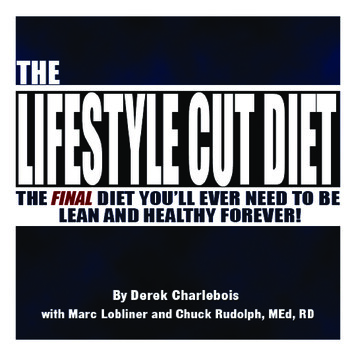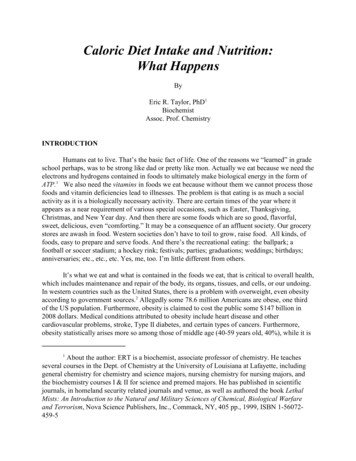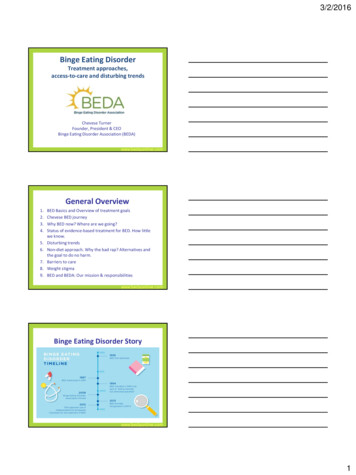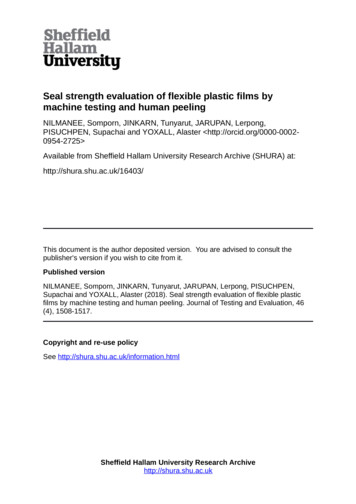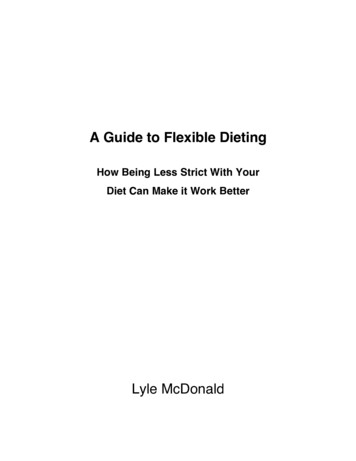
Transcription
A Guide to Flexible DietingHow Being Less Strict With YourDiet Can Make it Work BetterLyle McDonald
This book is not intended for the treatment or prevention of disease, nor as a substitute for medicaltreatment, nor as an alternative to medical advice. It is a review of scientific evidence presented forinformation purposes only. Use of the guidelines herein is at the sole choice and risk of the reader.Copyright: 2005 by Lyle McDonald. All rights reserved.This book or any part thereof, may not be reproduced or recorded in any form without permission inwriting from the publisher, except for brief quotations embodied in critical articles or reviews.For information contact:Lyle McDonald1587 Thornhill Dr. #1109Taylorsville, Ut 84123email: lylemcd@bodyrecomposition.comISBN: 0-9671456-5-1FIRST EDITIONFIRST PRINTINGPage 2http://www.bodyrecomposition.com
AcknowledgmentsMy main acknowledgments go out to my innumerable guinea pigs and test subjects who havehelped me develop some of my ideas, especially regarding structured refeeds.Beyond that, I’m only going to acknowledge my own completion of 2 books at the same time.Trust me, I deserve it.Page 3http://www.bodyrecomposition.com
Table of ContentsIntroductionChapter 1 This is not your father's diet bookChapter 2 A brief tangent: weight vs. fat lossChapter 3 Why diets fail part 1: Bodyweight RegulationChapter 4 Why diets fail Part 2: IntroductionChapter 5 How dieters fail dietsChapter 6 How diets fail dietersChapter 7 Introduction to flexible dietingChapter 8 Determining your bodyfat percentageChapter 9 Free mealsChapter 10 Structured refeeds: Part 1Chapter 11 Structured refeeds: Part 2Chapter 12 The full diet break: IntroductionChapter 13 Eating at maintenanceNon-calculating method Part 1Chapter 14 Eating at maintenanceNon-calculating method Part 2Chapter 15 Eating at maintenanceCalculation MethodChapter 16 Moving back into dietingAppendix 1Page 3641495761707985
IntroductionSee if this sounds familiar: you’ve just started a new diet, certain that it’s going to be different thistime around and that it’s going to work. You’re cranking along, adjust to the new eating (and exercise)patterns and everything is going just fine. For a while.Then the problem hits. Maybe it’s something small, a slight deviation or dalliance. There’s a bagof cookies and you have one or you’re at the mini mart and just can’t resist a little something that’s not onyour diet. Or maybe it’s something a little bit bigger, a party or special event comes up and you knowyou won’t be able to stick with your diet. Or, at the very extreme, maybe a vacation comes up, a fewdays out of town or even something longer, a week or two. What do you do?Now, if you’re in the majority, here’s what happens: You eat the cookie and figure that you’veblown your diet and might as well eat the entire bag. Clearly you were weak willed and pathetic forhaving that cookie, the guilt sets in and you might as well just start eating and eating and eating.Or since the special event is going to blow your diet, you might as well eat as much as you canand give up, right? The diet is obviously blown by that single event so might as well chuck it all in thegarbage. Vacations can be the ultimate horror, it’s not as if you’re going to go somewhere special for 3days (or longer) and stay on your diet, right? Might as well throw it all out now and just eat like you want,gain back all the weight and then some.What if I told you that none of the above had to happen? What if I told you that expecting to beperfect on your diet was absolutely setting you up for failure, that being more flexible about your eatinghabits would make them work better? What if I told you that studies have shown that people who areflexible dieters (as opposed to rigid dieters) tend to weigh less, show better adherence to their diet inthe long run and have less binge eating episodes?What if I told you that deliberately fitting in ‘free’ (or cheat or reward) meals into your diet everyweek would make it work better in the long run, that deliberately overeating for 5-24 hours cansometimes be a necessary part of a diet (especially for active individuals), that taking 1-2 weeks off ofyour diet to eat normally may actually make it easier to stick with in the long run in addition to making itwork better.I can actually predict that your response is one of the following. Some may think I’m making thesame set of empty promises that every other book out there makes. But I have the data and real-worldexperience to back up my claims. Or, maybe the idea of making your diet less strict and miserable issomething you actively resist. I’ve run into this with many dieters; they seem to equate suffering andmisery with success and would rather doom themselves to failure by following the same pattern thatthey’ve always followed rather than consider an alternate approach. Finally, maybe what little I wroteabove makes intuitive sense to you and you want to find out more.Regardless of your reaction to what I’ve written, I already have your money so you might as wellread on.I should probably warn you that this isn’t a typical diet book. You won’t find a lot of rah-rah ormotivational types of writing, there are no food lists and no recipes. There are thousands of other booksout there which fit that bill if that’s what you want but this isn’t it.Page 5http://www.bodyrecomposition.com
Chapter 1: This is not your father’s diet bookI want to make it very clear that the booklet you’re holding in your hand is not a diet book by anysort of conventional definition. You won’t find food lists or recipes in most of my books (I made a slightconcession in the Rapid Fat Loss Handbook) and certainly not in this one.Rather, this book is more about some of the psychological and behavioral aspects of dieting. I’llintroduce you to the concepts of flexible versus rigid dieting, free meals, structured refeeds and evenfull, two-week diet breaks. All of these are strategies to help you, in the long run, stay on your diet andmaintaining the weight that you worked so hard to lose. And although I will make a few comments aboutdieting in general, within the context of this booklet I’m not going to tell you to follow this, that or the otherdiet.Losing weight: the bottom lineRegardless of the nonsense you read in most diet books, losing weight is not fundamentallydifficult. In my honest opinion, the last 30 years of research has told us all we really need to know aboutthe topic. My grandmother knew how to lose weight before that but everybody knows thatgrandmothers know everything.The bottom (and rather simple) line is that you have to adjust your food intake (or activity levels)so that you’re burning more calories than you take in. Over time, this causes you to lose weight (I’ll bemaking a distinction between weight and fat loss in the next chapter). That’s really it and I’ve joked thatmy job is to turn the idea “Eat less, exercise, and repeat forever” into a 300 page book. One of thesedays I’ll write/finish my magnum opus but for right now, this is what you get.Even the books that tell you that you don’t have to count calories still ultimately trick you intoeating less, by adjusting what you can eat (and sometimes when you can eat it). Low-carbohydrate,low-fat, the Zone, you name a diet and they are making you eat less food in the long run. There’s simplyno way to escape that, no matter what magic they promise. Other weight loss approaches take theexercise route, get you burning more calories through activity under the assumption that you won’t justeat more to compensate (which tends to be a rather bad assumption most of the time). There’s reallynothing magical to weight loss no matter what you want to believe.Quite in fact, no weight loss study ever has found people who don’t lose some amount ofweight. They all do even though weight loss varies quite a bit between individuals (for a variety ofreasons). All of the people you know (or you yourself) who have dieted have lost weight, too. Youcan’t deny that. Eat less or exercise more and you will lose some amount of weight. How muchdepends on several factors depending on the severity of the diet, how long you stay on it, gender,genetics and a host of other stuff. But, fundamentally, losing weight is not difficult. Eat less, exercise (orboth), repeat forever. That’s the bottom line and the sooner you accept that the closer you’ll be tooreaching your goal.Page 6http://www.bodyrecomposition.com
So what’s the problem?You’ve probably heard the statistic that something like 95% of people regain all of the weightthat they’ve lost within a few years. While this exact number may or may not be correct, the generalconcept is: most people who lose weight (through any method) will gain it all back within some period oftime (months to a few years). Sometimes they gain back more weight than they started with and endup even fatter. Now, a number of groups use this statistic to claim that ‘Diets don’t make you loseweight’ but that’s completely inaccurate. Any diet that alters your energy intake (food) to expenditure(activity) will cause you to lose weight.It’s simply that most people don’t maintain that weight loss in the long run. They lose it, butthen they gain it all back (or more). Or at least gain back some proportion of it back. This is an importantdistinction that must be made: it is not that diets don’t cause weight loss, they all do. Most dieters simplyregain all the weight that they lose back.As I stated above, research has been looking at different diets, different nutrients to see what dietis ‘best’ for losing weight. Well, there is no absolute best, it depends on the person. Activity levels,food preferences, gender, genetics all seem to affect which diet is ‘best’ for a given person (althoughthere are some generalities that all diets must meet that I’ll address later). About the best summary I’veseen is that, if there is an optimal diet for the treatment of obesity, it should contain plenty of lean protein,lots of high fiber vegetables and fruits, moderate amounts of refined starches and moderate amounts offat. Yippee, 30 years and millions of dollars of research to conclude what my grandmother knew allalong.In any event, asking which diet is best for weight loss is the wrong question to be asking in thefirst place as far as I’m concerned. At this point in the game, we know how to make people lose weight:you get them to eat less, get them to move more, and get them to repeat that forever. Yes, certainlyresearch is showing that some approaches work better than others (though no single approach can beright for everybody in my opinion) but that’s all water under the bridge, we know most of what we needto know about causing weight loss to occur.So the problem is not weight loss; rather, the problem is with maintenance of weight loss.Researchers have to figure out how to get people to keep the weight/fat off that they lost in the longterm. The issue has more to do with long-term adherence to diet and activity changes, not so much whatthose changes should be.To me, that’s the far more interesting (and complicated) question: why are people so poor atmaintaining weight loss? More generally, why do most people fail at changing most behaviors. That is,a severe failure rate is not isolated to weight loss, the simple fact is that most people will fail to changeany of their long-standing behavior patterns. Whether it’s drinking, drug use, smoking, eating or theirexercise patterns, most people will revert back to their old patterns fairly quickly.In my opinion, the diet people (or the alcohol or drug people) need to get thepsychology/behavioral people into the game, figure out why people are just so damn resistant to longterm behavior change. Figure that out and you’ve solved most of the problems. Since I don’t think thatanswer is coming any time soon, I can only present the data I currently have to work with in thisregards.Page 7http://www.bodyrecomposition.com
So what’s the solution?I’d either be delusional or the ultimate egotist (some of my critics would say I’m both) to think Ihad the complete solution to the problems that face dieters. If I had some nifty magic trick (which is whatall diet books claim to have) for quick, easy weight loss or just told you that I did, I’d be a much richerman. I don’t and I won’t pretend that I do. There are no guarantees and nothing I am going to present inthis booklet should be construed or misconstrued as such.However, there are certain types of behaviors that are associated with greater success rates interms of dieting or exercise programs or what have you. Don’t misunderstand me, you’ll still have towork and dieting is no fun no matter how you cut it. In the long-term, you still have to adjust your overallfood intake, you’ll probably have to adjust your activity levels. That doesn’t change and nothing I cansay or do changes that.What I mainly want to talk about is ways to make the reality of long-term dieting, the ‘repeatforever’ part a little easier to cope with psychologically. But I’m getting ahead of myself, this is just anintroductory chapter. The good stuff starts next.Page 8http://www.bodyrecomposition.com
Chapter 2: A brief tangent: Weight vs. Fat lossAlthough this trend is changing recently, most diet books tend to only talk about weight loss and Isuspect that most dieters only think in terms of weight loss. In this chapter, I want to make a distinctionbetween weight loss and fat loss before moving on to the meat of this particular booklet.If you have my Rapid Fat Loss Handbook, you’ll recognize this as being the exact same textreused (why should I bother rewriting the same information) and you can skip to the next chapter. If youaren’t aware of the distinction between bodyweight and bodyfat (and weight loss versus fat loss),please keep reading.Weight versus fat loss: they are not the same thingEvery tissue in your body (including muscle, bodyfat, your heart, liver, spleen, kidneys, bones,water, minerals etc.) weighs a given amount. We could (conceivably anyhow) take each of them out ofyour body, plop them on a scale and find out how much they weigh. Your total bodyweight iscomprised of the weight of every one of those tissues. But only some portion of your total weight is fat.For this reason, researchers and techie types frequently divide the body into two (or more)components including fat mass (the sum total of the bodyfat you have on your body) and lean bodymass (everything else). While there are different ‘types’ of bodyfat (a topic to be discussed in anupcoming book project), this is more detail than we need.Let’s say that we could magically determine the weight of only your fat cells. Of course, we knowyour total weight by throwing you on a scale. By dividing the total amount of fat into the totalbodyweight, you can determine a bodyfat percentage which represents the percentage of your totalweight is fat.Lean athletes might only have 5-10% bodyfat, meaning that only 5-10% of their total weight isfat. So a 200 pound athlete with 10% bodyfat is carrying 20 lbs. (200 * 0.10 20) of bodyfat. Theremaining 180 pounds (200 total pounds - 20 pounds of fat weight 180 lbs.) is muscle, organs,bones, water, etc. Researchers call the remaining 180 pounds lean body mass or LBM. I’ll be usingLBM a lot so make sure and remember what it means: LBM is lean body mass, the amount of yourbody that is not fat.In cases of extreme obesity, a bodyfat percentage of 40-50% or higher is not unheard of.Meaning that nearly one-half of that person’s total weight is fat. A 400 pound person with 50% bodyfatis carrying 200 lbs. of bodyfat. The other 200 pounds is muscle, organs, bones, etc. Again, 200pounds of LBM along with 200 pounds of fat.Most people fall somewhere between these two extremes. An average male may carry from18-23% bodyfat and an average female somewhere between 25-30% bodyfat. So a male at 180lbs. and 20% bodyfat is carrying 36 pounds of fat and the rest of his weight (144 lbs.) is LBM. A 150pound female at 30% bodyfat has 50 pounds of bodyfat and 100 pounds of LBM.Healthy levels of bodyfat are somewhat up to debate but most ‘authorities’ recommend 11-18%as being optimally healthy for males and 18-25% as being optimal for females. And, yes, this meansthat being too lean can have its own set of health problems as well but being too lean is generally notPage 9http://www.bodyrecomposition.com
the problem for the average diet book reader (I’m not trying to be mean here, just making a statement offact).I want to point out that even if you never achieve ‘healthy’ bodyfat levels, even a small fat loss(10% of your current weight) can vastly improve health. So if you currently weigh 250 and lose even 25lbs. and keep it off long-term, you will be healthier even if you are still above ‘optimal’ bodyfatpercentage levels.Why is this important?So let’s say you start a diet, reducing some part of your daily food intake. Maybe you startexercising, too. After some time period, you get on the scale and it says you’ve lost 10 lbs. That’s 10lbs. of weight. But how much of it is fat? Frankly, you have no way of knowing with just the scale (unlessit’s one of those Tanita bodyfat scales, which attempt to estimate bodyfat percentage but don’t workvery well in my opinion). You could have lost fat or muscle or just dropped a lot of water. Even a bigbowel movement can cause a weight loss of a pound or two (or more, depending). A colonic that clearsout your entire lower intestinal tract may cause a significant weight loss. The scale can’t tell you whatyou’ve lost, it can only tell you how much you have lost.When you’re worrying about long-term changes, the real goal is fat loss (some LBM loss isoccasionally acceptable but that’s more detail than I want to get into here). That is, cycling water weighton and off of your body (as frequently happens with certain dieting approaches) isn’t really moving youtowards any real goal even if makes you think you are. Don’t get me wrong, it may be beneficial in theshort-term (I mentioned a few of those situations in The Rapid Fat Loss Handbook) but it doesn’trepresent true fat loss.In my last booklet, I brought up this issue since the diet I was describing tends to cause bothrapid fat and weight losses (from water weight loss) and I wanted readers to be clear of the distinction. Imainly bring this issue up in this booklet because I’m going to have you get a rough estimate of yourbodyfat percentage later in this book. That estimate will be used to determine how to use the varyingflexible dieting strategies I’m going to describe. For that reason, a basic understanding of bodyfatpercentage is necessary.The real take home message of this chapter is this: your body can be divided up into two majorcomponents, lean body mass (or LBM) and fat mass. The total amount of fat you are carrying dividedby your total bodyweight gives us your bodyfat percentage. I could have just written that shortparagraph and skipped everything else but I have to justify the cost of this booklet somehow.Page 10http://www.bodyrecomposition.com
Chapter 3: Why Diets Fail Part 1Bodyweight RegulationI mentioned in chapter 1 the rather dismal success rates for weight loss (and most types ofbehavior change). Again, the typically claimed statistic for dieters is that 95% will regain all of the weightthat they lost within a few years. The reasons why are the topic this and the next few chapters.Now, one of the longer standing debates, with a lot of flip-flopping over the years is whetherdiets are failing for biological or psychological reasons. Now, first off let me say that the distinction is afalse one and you can’t ever separate the two: biology affects psychology and psychology affectsbiology.However, for the purpose of this discussion and this booklet, I’m going to make that veryseparation. Just realize that I’m only making it for convenience. At the end of the day, both biologicaland psychological factors are interacting and solving (or even trying to solve) the problems associatedwith long-term weight maintenance mean dealing with both.In this chapter, I want to deal with the biology of dieting and bodyweight regulation (this will makemore sense in a second), in the next chapter, I’m going to deal with some of the morepsychological/behavioral factors that tend to make long-term weight loss an issue. I should note that ifyou’ve read either of my other two booklets (Bromocriptine or The Ultimate Diet 2.0), you can probablyskip most of this, there’s nothing much new here. If not, please read this chapter first.What is regulation?To understand what I’m talking about when I refer to bodyweight regulation, I should probablydefine what it means for a system to be regulated in the first place. When a system is regulated, thatmeans that it attempts (through whatever means) to maintain itself around some predetermined level.The example I’ve used over the years is of the thermostat in your house so that’s what I’m going to usehere.So let’s say that you set the thermostat to some temperature, let’s choose 70 degrees. Now,the thermostat has a thermometer in it which is keeping track of the temperature. If the temperature goesmuch below 70 degrees, the heat turns on; if it goes much above 70 degrees, the air conditioner comeson. The end result is that the temperature in your house will stay, within some range, around thetemperature you have set the thermostat to. That’s a regulated system.You can probably think of other regulated systems, an easy example might be the cruise controlin your car. You set it to a certain speed and the car has a measurement device that changes how muchgas is going to the engine depending on your speed: when the car slows down, more gas is given sothat you speed up; when you start going too fast, less gas is given (or the brake is applied).Of course, in both systems, the change in output (temperature or speed) changes the input,which is how the system stays regulated: it’s just a giant loop. So the temperature drops, the thermostatsenses it, the heat comes on, which increases the temperature, which the thermostat senses, turning theheat off. Schematically, the system looks like the following.Page 11http://www.bodyrecomposition.com
Figure 1: Schematic of a regulated mostat/thermometer(Cruise control)Heater/AC(Accelerator/Brake)Bodyweight regulationNow, many, if not most systems in the human body are regulated. Consider body temperaturewhere the body strives to maintain a rather normal level (98.6 Fahrenheit in the US, I have no idea whatthat is in Celsius). If you are put somewhere cold, your body will make you shiver, as well as cutting offblood flow to your extremities (this is why fingers and toes get so cold) to try and keep your body heatup. Go into the heat or exercise and your body sweats and increases blood flow to the extremities totry and get rid of the excess heat so that you don’t overheat.Another highly regulated system is blood pressure with the body making rapid adjustments totry to maintain blood pressure within fairly narrow limits. The body’s blood glucose levels are similar.So is water balance, if you get a little bit dehydrated, your body will change a bunch of processes sothat you retain water; if you drink a lot of water, you’ll pee more to get rid of the excess. On and on itgoes and if I sat down and thought about it, probably every other system in your body is equallyregulated. So what about bodyweight?After three decades of research and endless argument in the journals, it’s now well establishedthat human bodyweight is regulated (it might be more accurate to say that bodyfat percentage isregulated). Animal studies decades ago demonstrated that the animals would strive to maintain arelatively stable bodyweight. If you diet them down, they will become less active and slow metabolicrate, rapidly returning to their previous weight when you give them access to food. The same worked inreverse, overfeed them and they will turn off hunger and increase activity rapidly returning to theirprevious weight.In humans, studies had demonstrated that metabolism would slow more than you’d predict (forthe weight loss) when you dieted people. To a smaller degree, metabolism would also go up whenyou overfed them. As well, appetite and activity would change accordingly: activity would go downand appetite would go up when people were dieted and activity would tend to increase and appetitewould go down when you overfed them. All of which tended to affect bodyweight/bodyfat.In essence, the body is more or less trying to maintain a given level of bodyfat, that level beingcalled the ‘setpoint’. I should mention here that not all scientists agree with the idea of a rigid setpoint,they prefer to think in terms of a settling point, that is a bodyweight/bodyfat level that you will settle atdepending on circumstances of diet and exercise. This would be roughly equivalent to setting yourPage 12http://www.bodyrecomposition.com
thermostat higher in the winter and lower in the summer or the cruise control faster on the freeway andslower in town (where the speed limit is lower). You pick a different set(tling) point depending on thecircumstances.So a given individual might settle at one bodyfat level (and maintain around that level fairlyclosely) if they were inactive and eating the modern American diet and settle at a different (and generallylower) bodyfat level if they start exercising and eating better. They would regulate just fine around thosesettling points (i.e. their bodyweight would fluctuate a little bit) but they’d have to change habits to alterthe settling point very much.If you think about this within the context of human weight gain, the idea of a settling point isprobably a little closer to the truth: people don’t continue gaining weight indefinitely. Rather, based ontheir environment (and, of course genetics), they gain some amount of weight and then stay prettystable around that new weight. So while you may have weighed a fairly lean 150 in college, when youwere active and too poor to afford a lot of food, you stayed around that level of weight. Now that you’reolder and less active (and can afford more food), you’re maintaining at 180 or 200, but you’re notcontinually gaining weight.Anyhow, the issue of set vs. settling points is sort of tangential to the topic of this chapter. Themain idea I want you to take away from this is that within some range, the body appears to ‘defend’(another way of saying ‘regulate’) bodyweight against change to some degree or another. By ‘defend’,I mean that it adjusts its physiology to try and maintain that set/settling point within a certain range.Towards this goal, the body can, in premise anyhow, adjust metabolic rate, appetite and a whole host ofother systems up or down to try and defend against changes in bodyfat or bodyweight.The physiology of bodyweight regulation: a (very) brief primerSo let’s say you go on a diet, increasing activity or decreasing food intake. Your body sensesthis and should decrease metabolic rate, increase appetite, decrease activity levels and make fatmobilization and loss more difficult in response. This would make it progressively more difficult to loseweight and easier to regain the lost weight once it was lost. Depending on a host of circumstances,including gender, genetics, and starting bodyfat percentage (with some others), the body does thispretty well.Both during a diet as well as afterwards (in what are called the ‘post-obese’), metabolic rate tendsto be depressed, fat mobilization and burning is decreased, appetite and hunger are increased, andthere is a host of other stuff going on. This all serves to make regaining fat after the diet that much easier,something anyone who has fallen off their diet knows all too well: the fat comes on much more rapidlythen it came off. I should mention there that this is part of the reason that exercise has been shown tohave a greater effect at helping to maintain weight loss than to increase weight (or fat) loss on a diet:exercise helps to offset some of the negative adaptations that occur after weight loss.In the reverse direction, the body should increase metabolic rate, decrease appetite, increaseactivity and make fat mobilization easier when you gain weight. However, for reasons discussed indetail in my Bromocriptine book, the system is asymmetrical and most people find it far far easier to gainweight than to lose it. The basic reason, for folks who didn’t read that book, being that getting fat wasnever a problem during our evolutionary past, while starving to death was a very real possibility. So,Page 13http://www.bodyrecomposition.com
unlike animals (for whom getting fat means becoming something else’s lunch), humans never evolved agood defense against gaining weight. In general, we gain weight pretty easily (as the rapid increase inobesity in the modern world demonstrates) and lose it with more difficulty.I should mention that a lucky few appear to resist weight gain, their bodies tend to radicallyincrease caloric expenditure and decrease appetite when they start to overeat or gain weight.However, they are in the minority. There is also a group of people who seem to lose weight and fatfairly easily, they too are in the minority.Depressingly enough, the same people whose bodies resist weight gain the most tend to loseweight the most easily and vice versa: people who find weight loss the most difficult find weight gainrelatively easier.Researchers refer to these as spendthrift (lose weight easily, gain weight with difficulty) and thrifty(lose weight with difficulty, gain weight easily) metabolisms and are busily trying to determine themechanisms behind the spendthrift metabolism so they can figu
Chapter 1 This is not your father's diet book 6 Chapter 2 A brief tangent: weight vs. fat loss 9 Chapter 3 Why diets fail part 1: Bodyweight Regulation 11 Chapter 4 Why diets fail Part 2: Introduction 16 Chapter 5 How dieters fail diets 18 Chapter 6 How diets fail
